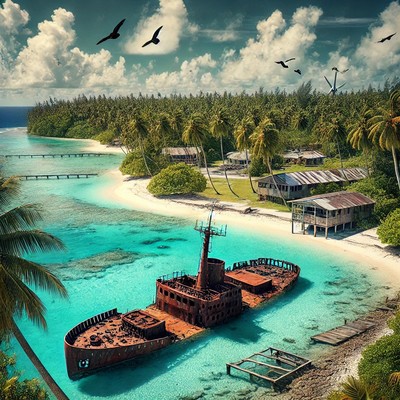Marshall Islands
TOUR IN
$4600
per person
Availability: 10 places
This Tour Has Been Planned But Dates Are Not Yet Definite And Due To Remote Location. Itinerary Is Subject To Change . The Itinerary Can Also Be Personalized And Tailored To A Small Group. DO NOT BOOK NOW .CONTACT US DIRECTLY travel@
Through vivid descriptions and personal encounters, we explore the islanders’ deep connection to the ocean, their traditional navigation skills, and the impact of climate change on their fragile homeland. Along the way, we dive into the crystal-clear lagoons, discover remnants of World War II history in Kwajalein, and experience the warmth and resilience of the Marshallese people.
Day 1
Majuro
Majuro, the capital of the Marshall Islands, is a small but fascinating destination with a mix of natural beauty, cultural experiences, and historical sites. Here are some top things to do while visiting Majuro:
1. Explore the Beaches and Lagoons
- Laura Beach – A stunning, peaceful beach on the western tip of Majuro Atoll, perfect for swimming, snorkeling, and relaxing.
- Enemanit Island – A small, secluded island that you can visit by boat for a day of snorkeling, picnicking, and enjoying clear waters.
- Alele Museum & Public Library – A small but insightful museum showcasing the history, culture, and traditional crafts of the Marshallese people.
2. Visit Historical and Cultural Sites
- Peace Park Memorial – A Japanese-built monument honoring those who died in the Pacific during World War II.
- World War II Relics – Scattered throughout the islands, these include bunkers and artifacts from the war.
- Local Handicraft Markets – Browse handwoven mats, baskets, and jewelry made from coconut fibers and shells.
3. Snorkeling and Diving
- Majuro Lagoon – Offers fantastic snorkeling with vibrant coral reefs and diverse marine life.
- Wreck Diving – There are sunken World War II ships and planes around the atoll, perfect for experienced divers.
4. Experience Local Culture
- Try Local Cuisine – Sample fresh seafood, coconut-based dishes, and local delicacies like breadfruit and pandanus.
- Attend a Traditional Dance Performance – If you’re lucky, you might catch a performance showcasing Marshallese storytelling through dance.
5. Take a Boat Trip to Outer Atolls
- Arno Atoll – Just a short boat ride away, this atoll offers even more pristine beaches, great fishing, and a more traditional island lifestyle.
Majuro is a quiet destination, perfect for those who enjoy nature, culture, and a laid-back island atmosphere.
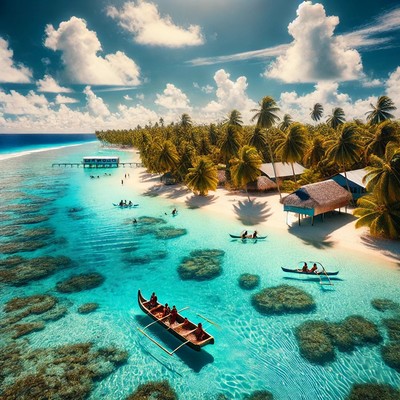
Day 2
Kwajalein Atoll
Kwajalein Atoll, home to the U.S. Army Garrison Kwajalein Atoll (USAG-KA), is a unique and historically significant destination in the Marshall Islands. However, access is highly restricted, as Kwajalein Island itself is a U.S. military installation, and only authorized personnel, military contractors, and invited guests can visit. If you have access, here are some of the top things to do in and around Kwajalein:
1. Explore World War II History
- WWII Relics and Sites – Kwajalein played a key role in the Pacific theater of World War II, and remnants like bunkers, gun emplacements, and sunken wrecks can be explored.
- Ebeye Island – Just a short boat ride away, this is the most populated island in the atoll and home to many Marshallese who work on Kwajalein. It offers a glimpse into local life and culture.
2. Snorkeling and Diving
- Sunken Warships & Aircraft Wrecks – The lagoon is a historic underwater museum with numerous wrecks from WWII, including Japanese ships and American planes.
- Vibrant Coral Reefs – The atoll's clear waters are home to thriving marine life, making it a paradise for snorkelers and divers.
3. Fishing & Water Activities
- Deep-Sea and Lagoon Fishing – The waters around Kwajalein are teeming with tuna, wahoo, and mahi-mahi, offering great opportunities for fishing.
- Kayaking & Paddleboarding – Calm lagoon waters make for excellent paddling experiences.
4. Beaches & Relaxation
- Coral Sand Beaches – While Kwajalein has fewer sandy beaches than other islands, there are still quiet spots to relax and enjoy the ocean views.
- Bucholz Army Airfield Overlook – A great spot to watch aircraft land with a stunning backdrop of the Pacific.
5. Visit Nearby Islands
- Enubuj (Carlson) Island – A quiet island with beautiful beaches and historical significance from WWII.
- Roi-Namur – Another military-controlled island in the northern part of the atoll with WWII history and excellent diving.
Since access is restricted, if you’re not affiliated with the military, the best way to visit Kwajalein is through special arrangements, such as being invited by a resident or participating in a research or business program.
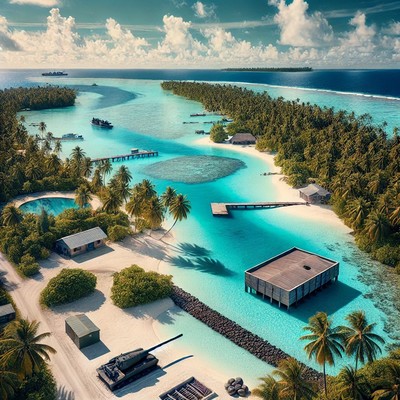
Day 3
Wojte Atoll
Wojte Atoll is one of the larger atolls in the Marshall Islands, known for its stunning natural beauty, historical significance, and quiet, remote atmosphere. Unlike Majuro or Kwajalein, Wotje is much less developed, making it an excellent destination for those seeking adventure, history, and cultural immersion.
1. Explore World War II Relics
Wotje was a major Japanese military base during World War II, and it still has some of the best-preserved war ruins in the Marshall Islands, including:
- Japanese Bunkers & Buildings – Concrete structures, gun emplacements, and bomb craters can still be found.
- Abandoned Airstrip – The remains of a Japanese airstrip are still visible, giving a glimpse into its wartime role.
- Wreckage & Artifacts – Sunken planes and other war debris can be explored, some of which are accessible for snorkeling.
2. Snorkeling & Diving
- Coral Reefs & Lagoon – The crystal-clear waters of Wotje are home to diverse marine life and beautiful coral formations.
- Wreck Diving – Some World War II wrecks in the lagoon make for exciting underwater exploration.
3. Visit the Remote Beaches
- Untouched White Sand Beaches – Since Wotje is sparsely populated, many of its beaches are pristine and empty.
- Shell Collecting & Beachcombing – The atoll’s shores are a great place to find unique shells and coral fragments.
4. Experience Local Culture
- Meet the Friendly Locals – Wotje has a small but welcoming population, mostly engaged in subsistence fishing and farming.
- Traditional Canoes & Navigation – If you’re lucky, you may see locals using traditional Marshallese canoes and navigation techniques.
- Churches & Community Life – The atoll has several small churches that are central to the island’s close-knit community.
5. Fishing & Island Hopping
- Fishing in the Lagoon – The waters around Wotje are rich in fish like tuna, snapper, and grouper.
- Exploring Nearby Islets – Since Wotje is a large atoll with many small islets, it’s a great place to hop between them by boat.
Getting to Wotje
- There are occasional domestic flights from Majuro to Wotje, but schedules can be inconsistent.
- Boats are another option, though travel time depends on weather conditions.
Wotje Atoll is perfect for history buffs, adventure seekers, and those looking for a peaceful, off-the-beaten-path experience in the Pacific.
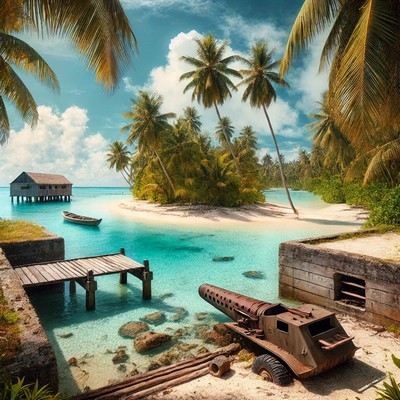
Day 4
Jaluit Atoll
Jaluit Atoll, located in the Marshall Islands, is a hidden gem rich in history, culture, and natural beauty. Once the capital of the Marshall Islands during the German and Japanese colonial periods, Jaluit offers a mix of historical exploration, stunning marine environments, and an authentic local experience.
1. Explore World War II History
Jaluit was a major Japanese military base during WWII, and remnants of this era can still be found, including:
- Sunken Ships & Aircraft Wrecks – Some can be seen while snorkeling or diving in the lagoon.
- Japanese Bunkers & Relics – Old fortifications, airstrips, and war-related structures scattered around the main island.
- Jabor Town – The main settlement in Jaluit, where you can find remnants of its colonial past, including the ruins of Japanese buildings.
2. Snorkeling & Diving
- Jaluit Lagoon – Crystal-clear waters filled with coral reefs, colorful fish, and WWII wrecks.
- Pristine Coral Reefs – The atoll’s reefs are teeming with marine life, making for excellent snorkeling and diving experiences.
3. Visit Remote Beaches & Islets
- Untouched White-Sand Beaches – Perfect for relaxing, picnicking, or just enjoying the peaceful environment.
- Traditional Fishing & Canoeing – Watch or participate in local fishing techniques and traditional outrigger canoe navigation.
4. Experience Marshallese Culture
- Meet the Locals – The people of Jaluit are welcoming, and visiting gives you a chance to learn about their daily life.
- Traditional Weaving & Handicrafts – The atoll is known for beautifully woven mats and handicrafts made from pandanus leaves and coconut fibers.
- Local Cuisine – Try fresh seafood, coconut-based dishes, and local staples like breadfruit and pandanus.
5. Birdwatching & Nature Exploration
- Birdwatching – Some of the smaller islets around Jaluit are home to seabirds and other wildlife.
- Mangrove Forests – Some parts of Jaluit have lush mangroves, offering a different side of the island’s ecosystem.
6. Take a Boat Trip Around the Atoll
- Island Hopping – Since Jaluit is made up of about 90 small islets, you can take a boat to explore different parts of the atoll.
- Traditional Canoe Rides – If you get the chance, ride in a traditional Marshallese sailing canoe, an important part of the island's heritage.
Getting to Jaluit
- Flights – Air travel from Majuro is available but limited and subject to weather conditions.
- Boat Travel – Slower but offers a more immersive experience of the Marshallese way of life.
Jaluit is perfect for history lovers, adventurers, and anyone looking for an authentic, off-the-grid island experience.
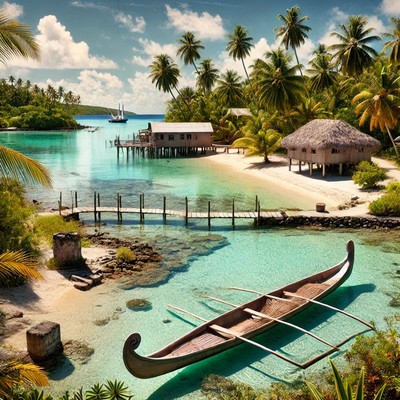
Day 5
Ebon Atoll
Ebon Atoll, the southernmost atoll in the Marshall Islands, is a remote and peaceful destination known for its rich history, lush landscapes, and strong cultural traditions. It was once an important center for early Western contact and missionary activity in the Marshalls. Today, Ebon remains an unspoiled paradise, ideal for travelers seeking authentic island life and natural beauty.
1. Experience Traditional Marshallese Culture
- Meet the Friendly Locals – Ebon has a small population that maintains a traditional island lifestyle.
- Learn About Canoe Building & Navigation – The atoll is home to skilled craftsmen who build and sail traditional outrigger canoes.
- Attend a Local Event or Church Service – Christianity has deep roots in Ebon, and attending a church service can be a great way to experience the community's spirit and music.
- Explore Handicrafts – Locals weave beautiful mats and baskets from pandanus and coconut leaves.
2. Discover Historical Sites
- Missionary Legacy – Ebon was the first atoll where Christian missionaries arrived in the Marshalls (in the 1850s), and traces of this history remain in its churches and stories.
- Old Mission Sites & Ruins – Some remnants of early missionary settlements and schools can still be seen.
3. Enjoy the Beaches & Lagoon
- Pristine White-Sand Beaches – Relax on secluded beaches with soft sand and coconut palms.
- Swim in the Crystal-Clear Waters – Ebon’s lagoon is perfect for swimming and enjoying the tropical environment.
- Snorkeling & Coral Reefs – The atoll's waters are home to colorful marine life, making for excellent snorkeling.
4. Explore Nature & Wildlife
- Mangrove Forests – Ebon has dense mangroves, which are important for the local ecosystem and great for exploration.
- Birdwatching – The atoll is home to various seabirds and other native species.
5. Try Traditional Island Foods
- Fresh Seafood – Enjoy locally caught fish and seafood, often cooked in traditional Marshallese styles.
- Coconut & Breadfruit Dishes – Staples of the Marshallese diet, often prepared in earth ovens or over open fires.
6. Go Fishing or Take a Canoe Trip
- Traditional Fishing Techniques – Watch or participate in fishing using nets, spears, or handlines.
- Canoe Rides Around the Atoll – Travel between islets in a traditional Marshallese sailing canoe.
Getting to Ebon Atoll
- Flights – Domestic flights from Majuro are available but infrequent.
- Boat Travel – A more traditional way to reach Ebon, though it takes longer and depends on weather conditions.
Ebon is an ideal destination for those looking to experience authentic Marshallese culture, untouched nature, and a slower pace of life.
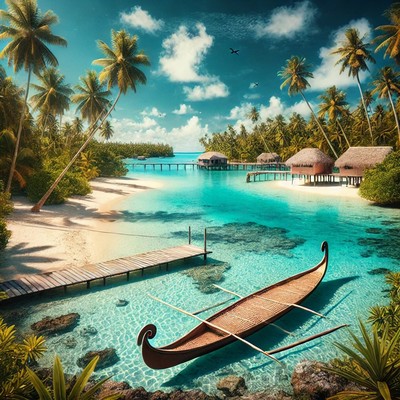
Day 6
Bikini Atoll
Bikini Atoll, part of the Marshall Islands, is one of the most historically significant and remote destinations in the world. Best known for its role in U.S. nuclear testing from 1946 to 1958, the atoll today is largely uninhabited and remains a UNESCO World Heritage Site. Despite its past, Bikini offers an unparalleled experience for history enthusiasts, adventure seekers, and divers.
1. World-Class Wreck Diving
Bikini Atoll is one of the top wreck diving destinations in the world, with several historic sunken warships from Operation Crossroads (nuclear tests). Due to radiation concerns, there are no permanent dive operations, but special expeditions are occasionally arranged.
- USS Saratoga (CV-3) – A massive aircraft carrier sunk by a nuclear explosion, now a top wreck dive site.
- Japanese Battleship Nagato – The former flagship of the Japanese Navy, which led the attack on Pearl Harbor.
- USS Arkansas (BB-33) – A battleship that was flipped upside down by a nuclear blast.
- Numerous Other Wrecks – Including destroyers, submarines, and aircraft, all resting at different depths.
2. Exploring Nuclear History
- Nuclear Test Sites – Although visiting the exact ground zero locations is restricted, guides can provide insight into the history of the tests that took place.
- Remains of Abandoned Buildings – The evacuated village of Bikini still has remnants of buildings from before the nuclear tests.
- Bikini Atoll's Story – Learn about the displacement of the Bikini islanders, who were forced to leave their homeland due to radiation contamination.
3. Enjoy the Remote Natural Beauty
- White Sand Beaches & Clear Waters – Despite its history, Bikini remains a stunning tropical paradise.
- Snorkeling & Marine Life – Due to the absence of human activity, marine ecosystems have flourished, making snorkeling in non-restricted areas amazing.
- Fishing (Restricted) – While fishing is generally not allowed due to radiation concerns, certain areas may be accessible depending on safety assessments.
4. Photography & Documentary Exploration
- Ghost Town Aesthetics – The abandoned village, rusting equipment, and shipwrecks make for hauntingly beautiful photography.
- Unique Landscape – The combination of history and untouched nature makes Bikini an intriguing subject for exploration.
Getting to Bikini Atoll
- Special Diving Expeditions – Dive charters occasionally visit Bikini from Majuro, usually requiring extensive planning.
- Boat Travel – Rare but possible, typically for scientific, historical, or documentary purposes.
Important Considerations
- Radiation Risks – While the lagoon is safe for diving, staying on land for extended periods is not advised due to lingering radiation.
- No Permanent Population – There are no tourist facilities; visits require special permits and logistical arrangements.
Bikini Atoll is not a typical tourist destination, but for those with a deep interest in history, wreck diving, or untouched beauty, it offers one of the most unique and hauntingly beautiful experiences in the world.
